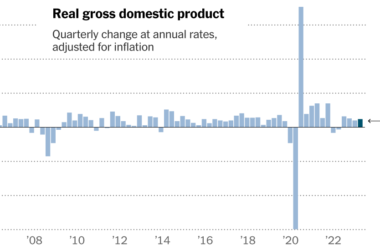America’s gross national debt exceeded $33 trillion for the first time on Monday, providing a stark reminder of the country’s shaky fiscal trajectory at a moment when Washington faces the prospect of a government shutdown this month amid another fight over federal spending.
The Treasury Department noted the milestone in its daily report detailing the nation’s balance sheet. It came as Congress appeared to be faltering in its efforts to fund the government ahead of a Sept. 30 deadline. Unless Congress can pass a dozen appropriations bills or agree to a short-term extension of federal funding at existing levels, the United States will face its first government shutdown since 2019.
Over the weekend, House Republicans considered a short-term proposal that would slash spending for most federal agencies and resurrect tough Trump-era border initiatives to extend funding through the end of October. But the plan had little hope of breaking the impasse on Capitol Hill, with Republicans still divided on their demands and Democrats unlikely to support whatever compromise they reach among themselves.
The debate over the debt has grown louder this year, punctuated by an extended standoff over raising the nation’s borrowing cap.
That fight ended with a bipartisan agreement to suspend the debt limit for two years and cut federal spending by $1.5 trillion over a decade by essentially freezing some funding that had been projected to increase next year and then limiting spending to 1 percent growth in 2025. But the debt is on track to top $50 trillion by the end of the decade, even after newly passed spending cuts are taken into account, as interest on the debt mounts and the cost of the nation’s social safety net programs keeps growing.
But slowing the growth of the national debt continues to be daunting.
Some federal spending programs that passed during the Biden administration are expected to be more costly than previously projected. The Inflation Reduction Act of 2022 was previously estimated to cost about $400 billion over a decade, but according to estimates by the University of Pennsylvania’s Penn Wharton Budget Model it could cost more than $1 trillion thanks to strong demand for the law’s generous clean energy tax credits.
Pandemic-era relief programs are still costing the federal government money. The Internal Revenue Service said last week that claims for the Employee Retention Credit, a tax benefit that was originally projected to cost about $55 billion, have so far cost the federal government $230 billion. The I.R.S. is freezing the program because of fears about fraud and abuse.
At the same time, several of President Biden’s attempts to raise more revenue through tax changes have been met with resistance.
In late 2022, the I.R.S. delayed by one year a new tax policy that would require users of digital wallets and e-commerce platforms to start reporting small transactions to the agency. The policy was projected to raise about $8 billion in additional tax revenue over a decade.
Last month, the I.R.S. delayed by two years a new provision that will stop high earners from being able to funnel extra money into their 401(k) retirement accounts. The agency described the delay as an “administrative transition period.”
Meanwhile, lobbyists are pressing for loopholes in new taxes that have been enacted. The 15 percent corporate alternative minimum tax was devised to ensure that rich companies could no longer get away with paying single-digit tax rates because of creative use of deductions. However, many of these companies have been pushing the Treasury Department, which is currently writing the rules that will govern the tax, to create exceptions to preserve their most prized deductions. That tax is different from the global minimum tax that most countries, except the United States, are working to adopt.
The pushback against efforts to raise revenue and cut spending has heightened the sense of alarm among budget watchdog groups that fear that a fiscal crisis is approaching.
“As we have seen with recent growth in inflation and interest rates, the cost of debt can mount suddenly and rapidly,” said Michael A. Peterson, the chief executive of the Peter G. Peterson Foundation, which promotes fiscal restraint. “With more than $10 trillion of interest costs over the next decade, this compounding fiscal cycle will only continue to do damage to our kids and grandkids.”
Republicans and Democrats in the House and the Senate continue to be divided on a path forward to avoid the near-term problem of a government shutdown, and lawmakers have started pressing for leaders to begin focusing on a stopgap bill to keep the government operating past Sept. 30.
Republicans have been pushing for cuts as a condition of funding the government, blaming out-of-control spending for the country’s fiscal woes.
“This town is addicted to spending other people’s money,” Representative Eli Crane, Republican of Arizona, said on X, formerly Twitter. “Enough is enough.”
But the White House blamed Republicans on Monday for the bulging debt burden.
“The increase in debt over the last 20 years was overwhelmingly driven by the trillions spent on Republican tax cuts skewed to the wealthy and big corporations,” said Michael Kikukawa, a White House spokesman. “Congressional Republicans want to double down on trickle-down by extending President Trump’s tax cuts and repealing President Biden’s corporate tax reforms.”
A Treasury Department report last week showed that the deficit — the gap between what the United States spends and what it collects through taxes and other revenue — was $1.5 trillion for the first 11 months of the fiscal year, a 61 percent increase from the same period a year ago.
In an interview with CNBC on Monday, Treasury Secretary Janet L. Yellen said she was comfortable with the nation’s fiscal course because interest costs as a share of the economy remained manageable. However, she suggested that it was important to be mindful of future spending.
“The president has proposed a series of measures that would reduce our deficits over time while investing in the economy,” Ms. Yellen said, “and this is something we need to do going forward.”
As reported in the Treasury Department’s daily report, America’s gross national debt has now exceeded $33 trillion for the first time. This milestone serves as a stark reminder of the country’s unstable fiscal trajectory. The timing is particularly crucial as there is a possibility of a government shutdown due to another fight over federal spending.
Congress is facing challenges in funding the government before the September 30 deadline. Failure to pass appropriations bills or agree on a short-term extension could result in the first government shutdown since 2019. House Republicans have considered a short-term proposal to cut spending for most federal agencies and revive Trump-era border initiatives. However, this plan is unlikely to break the impasse on Capitol Hill as Republicans remain divided on their demands, and Democrats are unlikely to support any compromise.
The issue of national debt has gained significant attention this year, with a prolonged standoff over raising the nation’s borrowing cap. While a bipartisan agreement was reached to suspend the debt limit for two years and cut federal spending by $1.5 trillion over a decade, the debt is projected to surpass $50 trillion by the end of the decade. The interest on the debt and the increasing cost of social safety net programs contribute to this growing burden.
Efforts to slow down the growth of the national debt face obstacles. Some federal spending programs, such as the Inflation Reduction Act of 2022, are expected to be more expensive than initially estimated. Pandemic-era relief programs continue to strain the federal government’s finances. Additionally, attempts by President Biden to raise more revenue through tax changes have faced resistance.
The resistance to increasing revenue and cutting spending has raised concerns among budget watchdog groups, fearing an approaching fiscal crisis. The compounding fiscal cycle, including more than $10 trillion of interest costs over the next decade, poses a threat to future generations.
There is a division among Republicans and Democrats in the House and the Senate regarding a solution to avoid a government shutdown. Lawmakers are pressing for a focus on a stopgap bill to keep the government operating beyond September 30.
Republicans have been emphasizing the need for cuts to address the country’s fiscal issues, attributing the problem to excessive spending. On the other hand, the White House placed the blame on Republicans, pointing to the trillions spent on tax cuts during the Trump administration. The Treasury Department’s recent report showed a 61 percent increase in the deficit compared to the same period last year.
Treasury Secretary Janet L. Yellen expressed confidence in the nation’s fiscal course, highlighting manageable interest costs as a share of the economy. However, she emphasized the importance of future spending considerations. The president has proposed measures to reduce deficits over time while investing in the economy.
In conclusion, America’s national debt reaching a record high has sparked concerns about the country’s fiscal stability. The ongoing debates over federal spending, tax changes, and revenue generation create challenges in controlling the growth of the debt. It is essential for policymakers to find a balanced solution that addresses both short-term funding issues and long-term debt management to protect future generations from the consequences of unsustainable fiscal practices.








